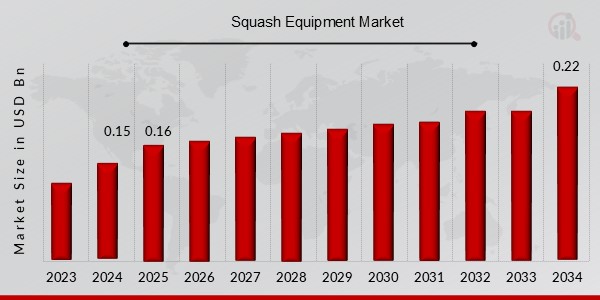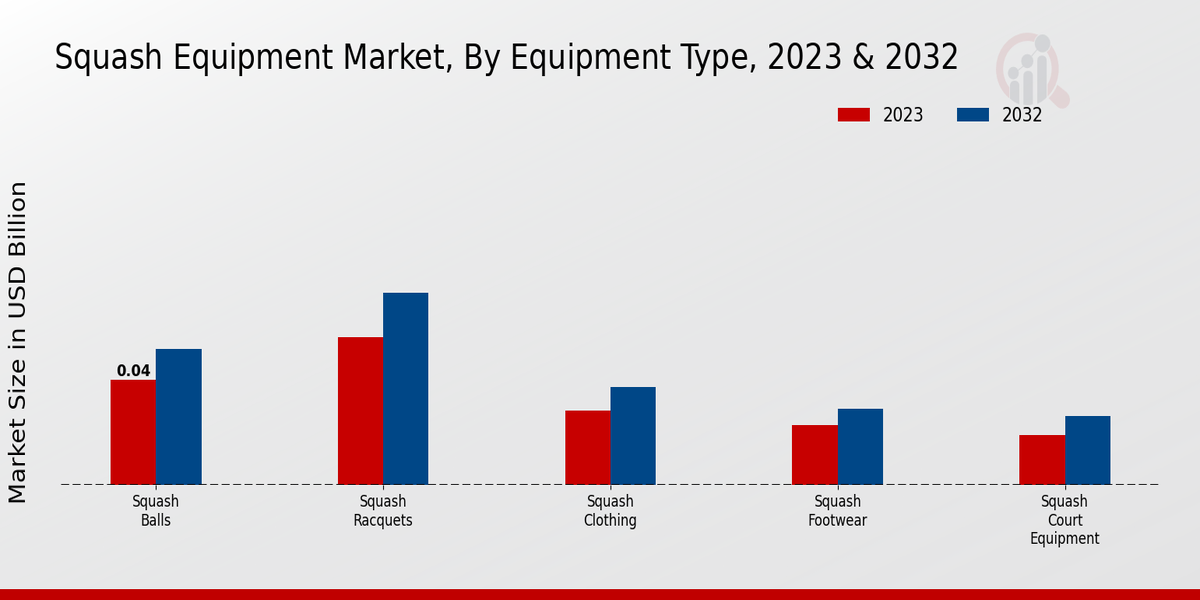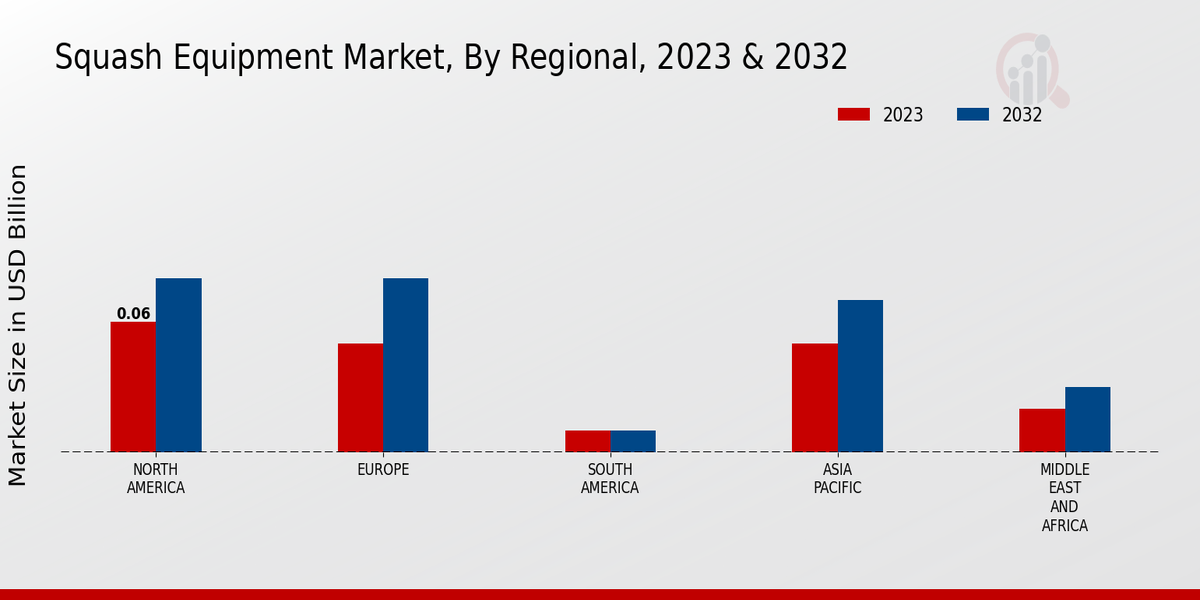Global Squash Equipment Market Overview
The Squash Equipment Market Size was estimated at 0.15 (USD Billion) in 2024. The Squash Equipment Industry is expected to grow from 0.16 (USD Billion) in 2025 to 0.22 (USD Billion) by 2034. The Squash Equipment Market CAGR (growth rate) is expected to be around 3.4% during the forecast period (2025 - 2034).
Key Squash Equipment Market Trends Highlighted
There is a revolution in squash equipment and it owes its success in part to the advances in materials: the use of carbon and other lightweight composites as well as the aerodynamic concepts in the design of squash equipment. The increasing performance, lifetime and comfort of any apparatus are always sought after by the players. Growing engagement in squash both as a competitive sport and for recreation drives increasing availability of quality equipment.
However, key industry growth factors are increasing participation, especially in new regions, and the expansion of professional squash leagues. Further opportunities are found in capturing the healthy and active demographic by marketing squash paraphernalia as a fun and effective workout. Recent trends encompass the use of smart devices such as wearables and sensors for training and performance optimization. Also, there is a rising trend of players looking for personal gear that suits them best.

Source: Primary Research, Secondary Research, MRFR Database and Analyst Review
Squash Equipment Market Drivers
Rising Popularity of Squash as a Fitness Activity
There are new trends that are impacting the Squash Equipment Market, such as the rise in popularity of squash as a form of fitness. Such a high intensity sport puts in motion every part of the body and allows to effectively strengthen and develop endurance. It is apparent that the increasing number of consumers who are health conscious has caused an increase in the number of players participating in squash in any way, professionally or for fun. Consequently, there has been an upsurge in the sale of available squash sports equipment and even accessories like squash shoes, squash balls, squash rackets, and other protective items.
In parallel, there are twice as many squash played in the world, with 790,000 players and 595 clubs to date.
Technological Advancements in Squash Equipment
The advancement in terms of technology of squash equipment is another major growth driver for the global market. The manufacturers design brand-new and more advanced products that serve to improve the quality and durability of the equipment. The impact of the products has seen the uses of different new equipment such as carbon fiber and graphene. In this, the structure of the equipment is made more lightweight and more durable, which in turn enables the player to better throw supervised.
In addition, the new materials used for making balls help in the production of efficient and tough balls. This has also increased the number of beginners being introduced to the sport while existing users of the sport are making changes in their equipment.
Growing Demand for Squash Equipment in Emerging Markets
The third main impetus in the Squash Equipment Market is the growing demand for squash equipment in emerging markets. Nowadays, the popularity of squash is growing in China, India, and Brazil, where the middle class is rapidly growing in numbers and their preference for leading a healthy lifestyle prompts them to actively participate in sports. In these countries, squash equipment may experience rapid demand growth in the future since such markets are relatively new and there are many potential consumers.In addition, squash equipment can be popular with the growing number of squash courts and tournaments in these countries.
Squash Equipment Market Segment Insights:
Squash Equipment Market Equipment Type Insights
The Equipment Type segment of the Squash Equipment Market holds immense significance, influencing market growth and industry dynamics. Squash Balls, Squash Racquets, Squash Clothing, Squash Footwear, and Squash Court Equipment are the key sub-segments within this category. Squash Balls: As the core component of the game, Squash Balls contribute significantly to the market, with revenue projected to reach USD 41.6 million in 2023. Their specific design and performance characteristics cater to different skill levels and playing preferences, driving demand.Squash Racquets: These specialized racquets are engineered to enhance player control and power. With technological advancements, manufacturers are introducing lightweight and durable racquets, fueling market growth. The segment is expected to generate USD 58.2 million in revenue by 2023, owing to the growing popularity of squash globally. Squash Clothing: Functional and comfortable clothing is essential for squash players, boosting market revenue to an estimated USD 29.3 million in 2023. Moisture-wicking fabrics, stretchability, and breathability are key attributes driving demand for specialized squash clothing.Squash Footwear: Purpose-built squash footwear provides stability, support, and agility during gameplay. The market is estimated to reach USD 23.7 million in 2023, with players seeking shoes that enhance their performance and reduce the risk of injuries. Squash Court Equipment: This sub-segment encompasses a range of specialized equipment used to construct and maintain squash courts. It includes flooring, lighting, back walls, and other accessories. The segment is expected to generate USD 19.5 million in revenue by 2023, as the expansion of squash facilities and the renovation of existing courts drive demand.Overall, the Equipment Type segment plays a vital role in the growth of the Squash Equipment Market. As squash gains popularity and participation increases, the demand for high-quality and specialized equipment is expected to continue driving market expansion in the coming years.

Source: Primary Research, Secondary Research, MRFR Database and Analyst Review
Squash Equipment Market Skill Level Insights
The skill level segment of the Squash Equipment Market is categorized into Beginner, Intermediate, Advanced, and Professional. Beginner players who are new to the sport typically purchase entry-level equipment, such as inexpensive rackets and basic shoes. As they progress to the Intermediate level, players invest in mid-range equipment that provides better control and power. Advanced players, who are more experienced and competitive, opt for high-performance rackets, shoes, and other accessories to enhance their gameplay. Professional players who compete at the highest level require top-of-the-line equipment that meets their rigorous demands.The Advanced and Professional segments are expected to grow significantly in the coming years, driven by increasing participation in competitive squash tournaments and the popularity of the sport among professional athletes.
Squash Equipment Market Distribution Channel Insights
The distribution channel segment plays a crucial role in the Squash Equipment Market, shaping market growth and revenue generation. Online channels have emerged as a significant force, capturing a substantial market share of over 35% in 2023 and projected to maintain a strong growth trajectory. The convenience, wide product selection, and competitive pricing offered by e-commerce platforms have driven their popularity among consumers. Offline channels, including specialty stores and multi-brand stores, continue to hold a significant portion of the market, with specialty stores catering to niche customer segments and offering personalized shopping experiences.Sports clubs also contribute to market revenue, providing access to squash equipment for enthusiasts and professionals alike. The distribution channel segmentation offers insights into consumer preferences, regional market dynamics, and competitive strategies, enabling market players to optimize their distribution networks and capture market opportunities.
Squash Equipment Market Regional Insights
The Squash Equipment Market is segmented into North America, Europe, APAC, South America, and MEA. Among these regions, North America and Europe are expected to dominate the market throughout the forecast period. The market growth in these regions can be attributed to the increasing popularity of squash as a sport and the presence of well-established squash infrastructure. APAC is also expected to witness significant growth in the squash equipment market, owing to the rising disposable income and the growing awareness of squash in the region.South America and MEA are expected to witness moderate growth in the squash equipment market due to the limited number of squash players and the lack of well-developed squash infrastructure in these regions. However, the increasing popularity of squash in these regions is expected to drive the growth of the squash equipment market in the coming years.

Source: Primary Research, Secondary Research, MRFR Database and Analyst Review
Squash Equipment Market Key Players And Competitive Insights:
Major players in the Squash Equipment Market industry are constantly striving to gain a competitive edge by introducing innovative products, expanding their distribution channels, and acquiring smaller players. Leading Squash Equipment Market players are investing heavily in research and development to create cutting-edge equipment that meets the evolving needs of squash enthusiasts. The Squash Equipment Market development is also being driven by the growing popularity of squash as a recreational and competitive sport, particularly in emerging markets. As a result, the Squash Equipment Market Competitive Landscape is expected to remain highly competitive in the coming years.Leading Squash Equipment Market players such as Dunlop, Tecnifibre, Harrow Sports, and Prince are constantly innovating to meet the demands of the growing squash community. Dunlop, for instance, has a long history of producing high-quality squash equipment, including rackets, balls, and shoes. The company's products are used by many of the world's top squash players, including Mohamed ElShorbagy and Nour El Sherbini. Tecnifibre is another leading Squash Equipment Market player that offers a wide range of squash equipment, including rackets, strings, and bags. The company's products are known for their durability and performance and are used by many professional squash players.Competitors in the Squash Equipment Market, such as HEAD, Karakal, and Ashaway, are also investing heavily in innovation and product development. HEAD, for instance, has a strong reputation for producing high-quality squash rackets, while Karakal is known for its innovative squash strings. Ashaway is another major competitor in the Squash Equipment Market and offers a wide range of squash equipment, including rackets, strings, and shoes. The company's products are used by many top squash players, including Nick Matthew and Laura Massaro.
Key Companies in the Squash Equipment Market Include:
- Gamma
- HEAD
- Prince
- Dunlop Sports Ltd.
- Babolat
- Ashaway
- Yonex
- Dunlop
- Tecnifibre
- SRAM
- Wilson
- Karakal
- Volkl
- HEAD US
- Black Knight
Squash Equipment Market Industry Developments
The Squash Equipment Market is anticipated to exhibit steady growth over the forecast period, owing to factors such as the rising popularity of the sport and increasing health consciousness. Key market players are focusing on product innovation and expansion into emerging markets to gain a competitive edge. Strategic partnerships and collaborations are also expected to shape the market landscape in the coming years. The increasing number of squash tournaments and leagues is expected to drive demand for high-quality equipment. Additionally, government initiatives aimed at promoting sports participation are expected to contribute to market growth. Technological advancements, such as the integration of sensors and tracking devices into squash equipment, are also expected to enhance the user experience and drive market expansion.
Squash Equipment Market Segmentation Insights
-
Squash Equipment Market Equipment Type Outlook
- Squash Balls
- Squash Racquets
- Squash Clothing
- Squash Footwear
- Squash Court Equipment
-
Squash Equipment Market Skill Level Outlook
- Beginner
- Intermediate
- Advanced
- Professional
-
Squash Equipment Market Distribution Channel Outlook
- Online
- Offline
- Specialty Stores
- Multi-brand Stores
- Sports Clubs
-
Squash Equipment Market Regional Outlook
- North America
- Europe
- South America
- Asia Pacific
- Middle East and Africa
| Report Attribute/Metric |
Details |
| Market Size 2024 |
0.15 (USD Billion) |
| Market Size 2025 |
0.16 (USD Billion) |
| Market Size 2034 |
0.22 (USD Billion) |
| Compound Annual Growth Rate (CAGR) |
3.4% (2025 - 2034) |
| Report Coverage |
Revenue Forecast, Competitive Landscape, Growth Factors, and Trends |
| Base Year |
2024 |
| Market Forecast Period |
2025 - 2034 |
| Historical Data |
2020 - 2024 |
| Market Forecast Units |
USD Billion |
| Key Companies Profiled |
Gamma, HEAD, Prince, Dunlop Sports Ltd., Babolat, Ashaway, Yonex, Dunlop, Tecnifibre, SRAM, Wilson, Karakal, Volkl, HEAD US, Black Knight |
| Segments Covered |
Equipment Type, Skill Level, Distribution Channel, Regional |
| Key Market Opportunities |
Demand for synthetic courts, technological advancements, growth of squash leagues and tournaments increasing popularity in emerging markets and rise of women's squash |
| Key Market Dynamics |
The rising popularity of squash Growth in the fitness industry Technological advancements |
| Countries Covered |
North America, Europe, APAC, South America, MEA |
Frequently Asked Questions (FAQ) :
The Squash Equipment Market is estimated to be worth around USD 0.16 billion in 2025.
By 2034, the Squash Equipment Market is expected to reach a valuation of approximately USD 0.22 billion.
The Squash Equipment Market is projected to exhibit a CAGR of 3.4% from 2025 to 2034.
North America is anticipated to hold a significant share of the Squash Equipment Market.
Squash equipment is primarily used for recreational and competitive squash games.
Some of the prominent players in the Squash Equipment Market include Dunlop, Harrow, HEAD, Prince, and Tecnifibre.
The increasing popularity of squash as a recreational and competitive sport is a key factor driving market growth.
Fluctuations in raw material prices and intense competition pose challenges to market growth.
Technological advancements, such as the development of smart squash balls, are emerging trends in the market.
Manufacturers are increasingly focusing on sustainable practices, such as using eco-friendly materials in equipment production.
















